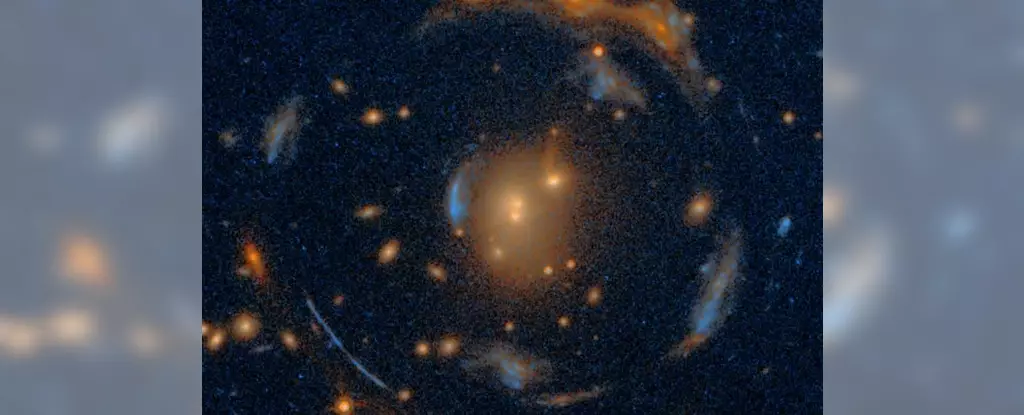Gravitational lensing, a mesmerizing phenomenon of astrophysics, acts as a cosmic magnifying glass, revealing the intricate details of the universe that would otherwise remain hidden to us. It manipulates the fabric of space-time, distorting the light from distant objects in fascinating ways. Recently, astronomers have made an exhilarating discovery known as the Carousel Lens, a stellar illustration of this ‘lens’ effect, which has opened new avenues in our understanding of the cosmos.
The Unveiling of The Carousel Lens
Astronomers utilizing the Hubble Space Telescope (HST) uncovered the Carousel Lens—a unique gravitational lens—revealing an astonishing alignment of seven galaxies distorted by a cluster of galaxies located in the foreground. This rare cosmic arrangement demonstrates how gravitational lensing can amplify our perspective on the universe, much like a funhouse mirror that provides an altered view. This particular alignment is being celebrated as a significant find that accentuates the precision of cosmic arrangements; as noted by Berkeley Lab senior scientist David Schlegel, discovering such a formation is tantamount to finding multiple needles in a haystack.
Discovered initially in data from the Dark Energy Survey, the Carousel Lens now serves as a focal point for astronomers keen to investigate the mass and influence of gravitational lensing on surrounding galaxies. The implications of this gravitational alignment extend beyond mere aesthetics. It opens up critical avenues for exploring ancient cosmic history, the imposing presence of dark matter, and answering various consequential questions in cosmology.
Typically, gravitational lenses consist of a substantial lensing object that distorts the light from more distant items, usually galaxies and quasars. The Carousel Lens, however, is distinguished by the remarkable distance between the elements involved—spanning millions of light-years—which makes it more complex. The lensing cluster, assigned the identifier DESI-090.9854-35.9683, resides approximately 5 billion light-years from Earth, a staggering distance that underscores the immense scale and reach of the universe.
The seven background galaxies that compose the Carousel Lens are believed to be located between 7.62 to 12 billion light-years away. Their unique arrangement, combined with the gravitational influence of the lensing cluster, has led to multiple distorted images of each galaxy. These peculiar formations result from the so-called ‘funhouse mirror’ effect, which alters their appearance significantly. Notably, a galaxy designated as “4a, 4b, 4c, 4d” creates a near-perfect depiction of what is known as an Einstein Cross, providing evidence of a symmetrical mass distribution within the lens.
According to Xiaoshang Huang, a researcher at Berkeley involved in the examination of the Carousel Lens, this discovery is a powerful example of a ‘strong lens’ in astronomical terms. The Carousel Lens marks an unprecedented alignment of seven galaxies appearing in five distinct groupings behind the foreground lensing cluster. The visual result is strikingly beautiful as these slingshot shadows form circular patterns reminiscent of a carousel.
The detailed modeling of the Carousel Lens affords an insightful view into various lensing configurations so often witnessed in astronomical observations. With various formations to analyze—such as arcs, diamond shapes, and the Einstein Ring—scientists are presented with the opportunity to decipher cosmological structures and explore gravitational effects. The differential distances between the lens and the lensed galaxies invite further exploration. This divergence in distances provides rich ground for understanding the clustering of matter in the universe.
This new lensing system also allows scientists to investigate outer space phenomena that enhance our knowledge of distant star sources. Notably, one particular source dubbed ‘Source 7’ appears to be a ‘quiescent’ galaxy, exhibiting characteristics that could provide insight into cosmic processes across eras. The knowledge extracted from such galaxies enables astronomers to probe the conditions of cosmic epochs long past.
Source 7’s peculiar reddish hue in infrared observations can be indicative of ‘early galaxy quenching,’ a phenomenon where star formation ceases within galaxies. Whether this cessation is a result of galactic mergers or the feedback loop involving supermassive black holes can help us unlock secrets about the early universe and its evolving structure.
The Carousel Lens serves as more than just a captivating sight in the sky; it embodies a tool through which researchers can deepen our comprehension of cosmic history and the events that molded the galaxies we perceive today. The study of such gravitational lenses is paramount as these intricate alignments facilitate the investigation of dark matter, dark energy, and the very elements that contribute to the tapestry of our universe. As astronomers continue to analyze the Carousel Lens and others like it, we can anticipate fresh revelations that expand our grasp of the cosmos and the intricate dance of celestial bodies within it.


Leave a Reply